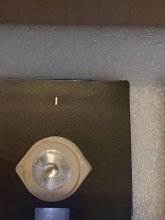I'm new to welding aluminum, so I'm passing on what I've been taught in that area. The acetone isn't just for contamination. The oxidation layer on aluminum can make it hard to form a puddle because the melting point of the oxidation is much higher than the base aluminum. That's what I was taught.
Using acetone to wipe the terminal clean should help remove any debris from sanding. The nature of the acetone - to me - indicates that it won't leave a residue.
Using acetone to wipe the terminal clean should help remove any debris from sanding. The nature of the acetone - to me - indicates that it won't leave a residue.



